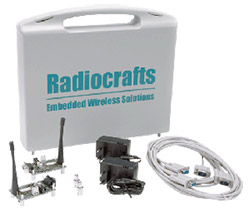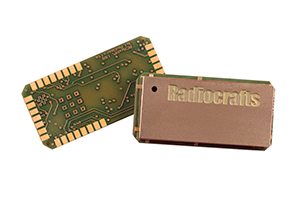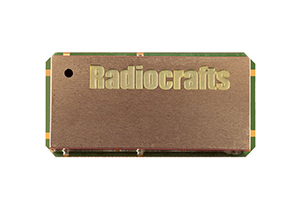ZNM is designed for ZigBee®, which is the mass market communication protocol for home automation, sensor networks and energy management systems with a large ecosystem of interoperable products. Operation at 2.45 GHz makes it a truly global solution, and the mesh network ensures in-house coverage. The RF module contains the ZNM network layer making it easy to build an interoperable product for any application profile. Radiocrafts has a wide range of modules at a low cost, which are design to be interoperable with ZigBee®, ranging from compact low power consumption modules used in battery operated devices, to high RF power modules with integrated antenna or external antenna connector.

WIRELESS MESH NETWORK

WORLDWIDE AVAILABLE FREQUENCY BAND

LOW BATTERY CONSUMPTION
ZNM Module Selection
RC24XX Family
The RC 24xx platform has options with an integrated antenna -AT and integrated antenna connector -CT. The Family includes HP variants for increased range.
Module |
Frequency band[MHz] |
Radio channels [#] |
Data rate [kbps] |
RX sensitivity [dBm] |
RX current [mA] |
Pout [dBm] |
TX current [mA] |
SLEEP current [uA] |
Operating supply voltage [V] |
Operating temperature [deg C] |
Indicative LOS [m] |
Region / compliance |
Narrowband |
High Power |
RC2400-ZNM |
2400-2483 |
16 |
250 |
-97 |
24 |
3 |
34 |
0,4 |
2,0 – 3,6 |
-30 to +85 |
500 |
Worldwide |
– |
– |
RC2400HP-ZNM |
2400-2483 |
16 |
250 |
-99 |
27 |
20 |
175 |
1,3 |
2,7 – 3,6 |
-30 to +85 |
2500 |
Worldwide |
– |
✓ |
RC2411AT-ZNM |
2400-2483 |
16 |
250 |
-97 |
24 |
3 |
34 |
0,4 |
2,0 – 3,6 |
-30 to +85 |
500 |
Worldwide |
– |
– |
RC2411CT-ZNM |
2400-2483 |
16 |
250 |
-97 |
24 |
3 |
34 |
0,4 |
2,0 – 3,6 |
-30 to +85 |
500 |
Worldwide |
– |
– |
RC2411HP-AT-ZNM |
2400-2483 |
16 |
250 |
-99 |
27 |
20 |
175 |
10 |
3,0 – 3,6 |
-30 to +85 |
2500 |
Worldwide |
– |
✓ |
RC2411HP-CT-ZMM |
2400-2483 |
16 |
250 |
-99 |
27 |
20 |
175 |
10 |
3,0 – 3,6 |
-30 to +85 |
2500 |
Worldwide |
– |
✓ |
Product Details
The RC24xx/HP ZNM RF Transceiver Modules are a family of compact surface mounted modules designed for the ZigBeeprotocol stack. It can also be used for wireless star and mesh networks based on an IEEE 802.15.4 compliant PHY and MAC. The complete shielded modules are provided in two footprints; 12.7 x 25.4 x 3.5 mm and 16.5 x 35.6 x 3.5 mm. They are offered in both a low-power consuming variant and a High Power version with LNA and power amplifier for extended range. The module is also available with integrated antenna or RF connector.
The modules are provided with a full ZNM Network Layer Module, based on the Z-Stack from Texas Instruments that is ZigBee® compatible. The ZNM support any application profile.
- Compact Shielded module (12.7 x 25.4 x 3.5 mm)
- Conforms with world-wide RF regulations
- High Power option in the same footprint
- Supported network topologies: Star, Mesh
- Integrated antenna or RF connector options
- Pin Compatible with other Radiocrafts modules
DATA SHEETS
File type: |
File name: |
File description: |
|---|---|---|
This document covers the relevant information about the ZNM series RC2400 and RC2400 HP module. You will find a description about product features, reference data, ZNM protocol, circuit and pin description, MCU considerations, power supply, programming interface, antenna connection. |
||
This document covers the relevant information about the ZNM series RC241X module. You will find a description about product features, reference data, ZNM protocol, circuit and pin description, MCU considerations, power supply, programming interface, antenna connection. |
||
This document describes the software command interface used in the ZNM modules from Radiocrafts, which is implemented using a CC2530-ZNP device from Texas Instruments. |
||
User Manual for ZNM modules is a step by step introduction how to use our module with the ZNM protocol. The document describes the ZNM feature sets, embedded protocol, the UART interface and timing, power management and supply voltage. The document also includes the descriptions of the ZNM Smart Energy options. |
APPLICATION NOTES
File type: |
File name: |
File description: |
|---|---|---|
Different applications and different use-cases will need different wireless connectivity technologies. Therefore, selecting the right wireless technology is a critical design decision. Based on radio performance requirements and other criteria, this selection guide will point out the differences between the technologies to help selecting the right one. |
||
This is a short Application Note on the use of license free RF modules in New Zealand, and in particular which modules from Radiocrafts will meet the local radio regulations. |
||
There are many different wireless standards and technologies available to enable the internet of things (IOT). The different technologies have different pro’s and con’s depending on the use case and the end customer. Trying to keep up with the latest wireless trends can drain a company of all its resources and take attention from its core business. The solution recommended by Radiocrafts is to use a modular approach and a common RF module footprint that enable all the technologies offered by Radiocrafts without modifications to the PCB. |
||
When selecting the right radio technology, the achievable communication range is an important factor. This document review how to analyse radio range based on parameter provided in the data sheets for the different module families. Some measurement results from practical range testing are also shown. |
||
The purpose of this document is to list some of the most common issues that customers report when using Radiocrafts modules, and the solution to these issues. |
||
The Radiocrafts Demo Boards and USB-sticks include an on-board firmware upgrade connector compatible with different flash programming adapters. It is also recommended that PCB layouts include a connector for firmware upgrade. This Application Note describes how to upgrade the firmware of any Radiocrafts RF module using either a CC Debugger or the FlashPro-CC tools. |
||
This application note describe how to port the Figure 8 Wireless Z-stack Home Control Lighting (HCL) example from the Chipcon CC2420DB to the Radiocrafts RC2200DK. The main difference between the two hardware platforms are the I/O ports used for LEDs and switches. Also, the RC2200 module does not have external RAM. |
||
The RC1xx0 and RC2x00 series of RF Modules with integrated protocol offers easy adaptation of wireless communication utilizing a simple UART serial interface. In their standard versions without any required configuration the modules offer two pins for controlling PA, LNA and SPDTs for signal switching. Two SPDTs are required since it is only one RF pin on the Radiocrafts modules. |

For all our SIGFOX modules, Development Kit suitcases are available for rapid prototyping and proof of concept. The kits contain:
- Two Development Boards with the module of choice, onboard USB level shifter and USB connector, SMA antenna connector, I/O break-out
- Quarterwave stub antennas with SMA connector
- USB cables
- the HP variants include additionally AC/DC Power Supplies with Country specific converters
One kit will make a wireless link “out of the box” and feature easy access to all the modules I/O-pins. The kit can be used together with the PC software tools.
File type: |
File name: |
File description: |
|---|---|---|
The Demonstration Kit from Radiocrafts is designed to make it easy for the user to evaluate the module, develop an application and build prototypes. Bundled with the Demonstration Kit is the RCTools PC software to be used together with the Demo Boards. |
||
This User Manual describes how to use the Demonstration Kit and provides detailed documentation for the Demonstration Board. |
Tools & Manuals
File type: |
File name: |
File description: |
|---|---|---|
RCTools is a powerful and easy to use PC suite that helps you during test, development and deployment of the Radiocrafts modules. The RCTools includes RC_CCT, RC_SA and RC_DT stand-alone applications running under windows .Net Framework. The RCTools is free of charge and easily installed (including .NET and USB Driver) by running the setup file. |
||
RC Tools ZNM contains the PC tools for design with the ZNM family. It includes the CCT tool. |
||
The ZNM-CCT (Configuration & Communication Tool) helps you to work with your Radiocrafts modules. The program enables you to easily configure the module and can additionally work as a terminal window, where data can be sent or received to / from any serial port. The RSSI (Received Signal Strength Indicator) informs you about the Link budget and helps you estimate range. |
Configuring a ZNM Network
The ZNM module uses a mesh network topology on top of the IEEE 802.15.4 PHY/MAC layer. In the mesh network the devices have different roles. In a network you will always have one (and only one) Coordinator and possible several Routers and End Devices.
- The Coordinator is the root/master of the network and starts the network and later holds information about the network
- A Router (Full Functional Device – FFD from IEEE 802.15.4) is an always-on device that including routing functionality.
- An End Device (Reduced Functional Device – RFD from IEEE 802.15.4) is a device with no routing capabilities, but with sleep capability. Such a device can sleep most of the time and only poll the network at regular interval.
The network is identified by a unique PAN-ID. This ID can be written to the module during configuration. Writing 0XFFFF to the PAN ID will make the Coordinator chose a random PAN-ID (after scan) and Routers/End Devices to join a random PAN.
The ZNM utilizes acknowledgement and retransmission on the MAC layer to ensure a reliable link. This means that each point-to-point communication will include an acknowledgement message. But in addition, an application end-to-end acknowledgement can be included.
The ZNM protocol includes powerful AES128 encryption. The encryption key can be preconfigured in each device or it can be set in the coordinator and distributed to the rest of the network depending on the security requirements.
In practice the network is established by sending some simple API commands to the ZNM module from a host MCU over the UART or SPI interface. The self-configuration and self-healing properties of the mesh network will make it a very robust network even when the environment change and new routes need to be established.
What is Zigbee?
ZigBee is an IEEE 802.15.4-based specification for a suite of high-level communication protocols used to create personal area networks with small, low-power digital radios.
The technology defined by the ZigBee specification is intended to be simpler and less expensive than other wireless personal area networks (WPANs), such as Bluetooth or Wi-Fi. Applications include wireless light switches, electrical meters with in-home-displays, traffic management systems, and other consumer and industrial equipment that requires short-range low-rate wireless data transfer.

For any module inquiries please contact our local partner.
Or buy online at Digikey.com
Product Name | Frequency | Region Compliant | Buy Module Online | Buy Development Kit Online |
RC2400-ZNM | 2400-2483 MHz | Worldwide | ||
RC2400HP-ZNM | 2400-2483 MHz | Worldwide | ||
RC2411AT-ZNM | 2400-2483 MHz | Worldwide | Contact Radiocrafts | |
RC2411CT-ZNM | 2400-2483 MHz | Worldwide | Contact Radiocrafts | |
RC2411HP-AT-ZNM | 2400-2483 MHz | Worldwide | Contact Radiocrafts | |
RC2411HP-CT-ZMM | 2400-2483 MHz | Worldwide | Contact Radiocrafts | Contact Radiocrafts |






